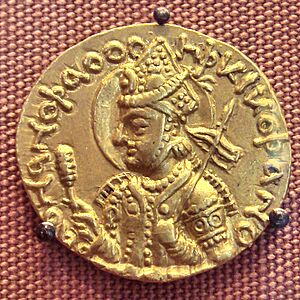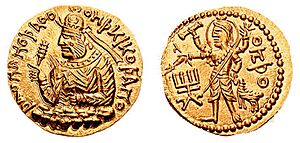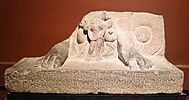Huvishka facts for kids
Quick facts for kids Huvishka |
|||||
|---|---|---|---|---|---|
| Kushan emperor | |||||

Coin of Huvishka. Legend in Kushan language and Greek script (with the Kushan letter Ϸ "sh"): ϷΑΟΝΑΝΟϷΑΟ ΟΟΗϷΚΙ ΚΟϷΑΝΟ ("Shaonanoshao Ooishki Koshano"): "King of kings, Huvishka the Kushan".
|
|||||
| Reign | 150–190 CE | ||||
| Coronation | 150 CE | ||||
| Predecessor | Kanishka | ||||
| Successor | Vasudeva I | ||||
| Born | 130 AD Kabul |
||||
| Died | 190 AD (59 years) Kashmir |
||||
| Burial | 190 AD Leh |
||||
| Spouse | Unknown | ||||
| Issue | Vasudeva I Kanishka II | ||||
|
|||||
| House | Unknown | ||||
| Dynasty | Kushan Dynasty | ||||
| Father | Kanishka | ||||
| Mother | Unknown | ||||
| Religion | Buddhism | ||||
Huvishka was a powerful emperor of the Kushan Empire. He ruled for about 30 years, from 150 CE until around 190 CE. He took over after Kanishka and was followed by Vasudeva I.
Huvishka's time as emperor was peaceful and helped make the Kushan Empire stronger. His empire stretched from Balkh in Bactria all the way to Mathura in India. We know this because his coins have been found in these places. Gold coins and special amulets with his picture were even found as far east as Pataliputra and Bodh Gaya. This suggests that the Kushan Empire might have reached very far east during his rule. He also moved the main city of the Kushan Empire to Mathura in the south.
Contents
Huvishka's Religious Beliefs
Huvishka was the son of Emperor Kanishka. His reign is often called a "golden age" for the Kushan Empire. He was known for supporting many different religions.
Buddhism and Huvishka
Huvishka's rule saw the first written proof of the Buddha Amitabha. This was found on a statue from the 2nd century in Govindo-Nagar, now in the Mathura Museum. The statue is dated to "the 28th year of the reign of Huvishka." It was given to "Amitabha Buddha" by a family of traders.
There is also some proof that Huvishka followed Mahāyāna Buddhism. An old Sanskrit writing says that Huvishka "set forth in the Mahāyāna." Some stone carvings from Gandhara also seem to show Huvishka giving gifts to the Buddha.
Huvishka clearly supported Buddhism. However, the Buddha does not appear on his coins. This might have been out of respect for the Buddha.
-
This is the earliest known writing about "Mahayana" Buddhism. It mentions "Amitabha Buddha" in the "year 26" of Huvishka's rule.
-
Here are the words "Bu-ddha-sya A-mi-tā-bha-sya" ("of Amitabha Buddha") written in Brahmi script on the inscription.
-
This is the base of a Buddha statue with Huvishka's name on it. It says "in the year 45" of his rule. It starts with Mahārājasya Huviṣkasya Devaputrasya... It is from Uttar Pradesh and is now in the Chhatrapati Shivaji Maharaj Vastu Sangrahalaya Museum.
Gods from Greece and Rome
Huvishka was the first and only Kushan ruler to put the Hellenistic-Egyptian god Serapis on his coins. Serapis was a very important god in Alexandria in Egypt. This shows that Huvishka was interested in Roman Egypt. This area might have been a big market for goods from the Kushan Empire.
Another coin might show the Roman goddess Roma, who was called "Rishti" (ΡΙϷΤ) or "Riom" (ΡΙΟΜ) on the coin.
-
A coin of Huvishka. On the front it says "King of kings, Huvishka the Kushan." On the back is Herakles with the name ΗΡΑΚΙΛΟ (Erakilo).
Iranian Gods
Huvishka also included gods from ancient Iran on his coins. Between 164 and 174 CE, he built a temple for Pharro (who represented "Royal splendor") and Ardoxsho in a strong fort called Ayrtam. This is known from the Ayrtam inscription. He also made many coins with the names of these gods.
Many other Iranian gods appear on his coins. These include Miiro (Mitra), Mao (the Moon god), Nana (Anahita), and Atsho (Atar, "The Royal fire"). Even the most important god in Zoroastrianism, Ooromozdo (Ahura Mazda), and Mazdo oana ("Mazda the victorious") are shown. Other Zoroastrian gods include Rishti ("Uprightness", Arshtat), Ashaeixsho ("Best righteousness", Asha Vahishta), and Shaoreoro ("Best royal power", Khshathra Vairya).
-
Huvishka with Ahuramazda (ωΡΟΜ, Orom[zdo]).
-
Huvishka with the Moon god Mah (Mao). You can see a crescent moon behind his shoulders.
Indian Gods

Huvishka also rebuilt a temple in Mathura. He made sure there was a place for Brahmans (Hindu priests) to stay. Some of Huvishka's coins also show Maaseno. This is the Kushan version of the Hindu god Karttikeya, also known as Skanda. This god was very important to the Yaudheya people.
Huvishka may have put this god on his coins when the Kushans took control of the Mathura area. This might have been a way to show respect to the Yaudheyas.
Unlike his father Kanishka, Huvishka also added Oesho ("ΟΗϷΟ", Shiva) to some of his coins. Instead of the Iranian god of war, he added several Indian war gods. These include Skando (old Indian Skanda), Komaro (old Indian Kumara), Maaseno (old Indian Mahāsena), and Bizago (old Indian Viśākha). He even included Ommo (old Indian Umā), who is Shiva's wife. This shows that the Kushans might have started to favor Indian gods more. It could also have been a way to get Indian warriors to join their army.
-
Coin of Huvishka with the Indian god Maaseno (old Indian Mahāsena).
-
Huvishka with Maaseno (old Indian Mahāsena) and his helpers.
Huvishka's Coins and Statues
Huvishka's coins are special because they have many different designs. He also made a very large number of gold coins. More gold coins from Huvishka have been found than from all other Kushan rulers combined! His main coin factories were in Balkh and Peshawar. Smaller ones were in Kashmir and Mathura.
One interesting mystery about Huvishka's rule is why his coins lost value. Early in his reign, the copper coins became much lighter. Their quality and weight kept dropping throughout his rule. By the time Vasudeva took over, a standard coin weighed much less. This drop in value led to many fake coins being made. People in the Gangetic valley wanted the older, heavier coins. We still don't know exactly why this happened.
|
|
|


























